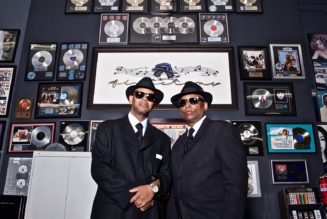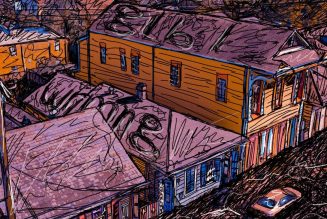The Opus: The Infamous is currently ongoing, and you can subscribe now. To celebrate the new season, stream Mobb Deep’s iconic album via all major streaming services. You can also enter to win a copy of The Infamous on vinyl — signed by rapper Havoc himself.


Spotify | Google Play | Stitcher | Radio Public | RSS
Follow on Facebook | Podchaser
If they’d never released another album after 1995’s The Infamous, Albert “Prodigy” Johnson and Kejuan “Havoc” Muchita of Mobb Deep would still reign as hip-hop visionaries 25 years later. Heavy on realism and scant on hope, the record stands as one of the most unflinching documents of hip-hop’s East Coast Renaissance. As our own Okla Jones put it in a recent retrospective, “The indelible legacy of [The Infamous] will be that it helped shift the content of hip-hop back towards a more journalistic, documentary style of music,” one that favored “reporting on the actual state of the Black community through its uncompromising language, bleak outlook, and cinematic imagery.”
While the record’s catalog of hardships surrounding street life in Queens remains as striking today as it did at the time of its release, so too does the innovative, unmistakable production style that amplified the power of those words.
“Credited with redefining the sound of hardcore rap with the incorporation of haunting piano loops, distorted melodies, and lo-fi synthesizers, The Infamous served as a shift in how artists would engineer their music for years to come,” Jones said in a classic album review. However, where those components came from is nearly as important as the artwork they joined to create.
<img data-attachment-id="1030728" data-permalink="https://consequenceofsound.net/2020/04/win-signed-mobb-deep-the-infamous/the-infamous-mobb-deep-havoc-signed-vinyl-copy-opus-podcast/" data-orig-file="https://consequenceofsound.net/wp-content/uploads/2020/04/The-Infamous-Mobb-Deep-havoc-signed-vinyl-copy-opus-podcast.jpg?quality=80" data-orig-size="1200,958" data-comments-opened="1" data-image-meta="{"aperture":"0","credit":"","camera":"","caption":"","created_timestamp":"0","copyright":"","focal_length":"0","iso":"0","shutter_speed":"0","title":"","orientation":"0"}" data-image-title="The Infamous Mobb Deep havoc signed vinyl copy opus podcast" data-image-description="
The Infamous Mobb Deep havoc signed vinyl copy opus podcast
” data-medium-file=”https://consequenceofsound.net/wp-content/uploads/2020/04/The-Infamous-Mobb-Deep-havoc-signed-vinyl-copy-opus-podcast.jpg?quality=80&w=300″ data-large-file=”https://consequenceofsound.net/wp-content/uploads/2020/04/The-Infamous-Mobb-Deep-havoc-signed-vinyl-copy-opus-podcast.jpg?quality=80&w=806″ class=”aligncenter size-large wp-image-1030728″ src=”https://consequenceofsound.net/wp-content/uploads/2020/04/The-Infamous-Mobb-Deep-havoc-signed-vinyl-copy-opus-podcast.jpg?quality=80&w=806″ alt=”The Infamous Mobb Deep havoc signed vinyl copy opus podcast” width=”806″ height=”643″ srcset=”https://consequenceofsound.net/wp-content/uploads/2020/04/The-Infamous-Mobb-Deep-havoc-signed-vinyl-copy-opus-podcast.jpg 1200w, https://consequenceofsound.net/wp-content/uploads/2020/04/The-Infamous-Mobb-Deep-havoc-signed-vinyl-copy-opus-podcast.jpg?resize=300,240 300w, https://consequenceofsound.net/wp-content/uploads/2020/04/The-Infamous-Mobb-Deep-havoc-signed-vinyl-copy-opus-podcast.jpg?resize=768,613 768w, https://consequenceofsound.net/wp-content/uploads/2020/04/The-Infamous-Mobb-Deep-havoc-signed-vinyl-copy-opus-podcast.jpg?resize=1024,817 1024w, https://consequenceofsound.net/wp-content/uploads/2020/04/The-Infamous-Mobb-Deep-havoc-signed-vinyl-copy-opus-podcast.jpg?resize=807,644 807w” sizes=”(max-width: 806px) 100vw, 806px”><img data-attachment-id="1030728" data-permalink="https://consequenceofsound.net/2020/04/win-signed-mobb-deep-the-infamous/the-infamous-mobb-deep-havoc-signed-vinyl-copy-opus-podcast/" data-orig-file="https://consequenceofsound.net/wp-content/uploads/2020/04/The-Infamous-Mobb-Deep-havoc-signed-vinyl-copy-opus-podcast.jpg?quality=80" data-orig-size="1200,958" data-comments-opened="1" data-image-meta="{"aperture":"0","credit":"","camera":"","caption":"","created_timestamp":"0","copyright":"","focal_length":"0","iso":"0","shutter_speed":"0","title":"","orientation":"0"}" data-image-title="The Infamous Mobb Deep havoc signed vinyl copy opus podcast" data-image-description="
The Infamous Mobb Deep havoc signed vinyl copy opus podcast
” data-medium-file=”https://consequenceofsound.net/wp-content/uploads/2020/04/The-Infamous-Mobb-Deep-havoc-signed-vinyl-copy-opus-podcast.jpg?quality=80&w=300″ data-large-file=”https://consequenceofsound.net/wp-content/uploads/2020/04/The-Infamous-Mobb-Deep-havoc-signed-vinyl-copy-opus-podcast.jpg?quality=80&w=806″ class=”aligncenter size-large wp-image-1030728″ src=”https://consequenceofsound.net/wp-content/uploads/2020/04/The-Infamous-Mobb-Deep-havoc-signed-vinyl-copy-opus-podcast.jpg?quality=80&w=806″ alt=”The Infamous Mobb Deep havoc signed vinyl copy opus podcast” width=”806″ height=”643″ data-lazy-srcset=”https://consequenceofsound.net/wp-content/uploads/2020/04/The-Infamous-Mobb-Deep-havoc-signed-vinyl-copy-opus-podcast.jpg 1200w, https://consequenceofsound.net/wp-content/uploads/2020/04/The-Infamous-Mobb-Deep-havoc-signed-vinyl-copy-opus-podcast.jpg?resize=300,240 300w, https://consequenceofsound.net/wp-content/uploads/2020/04/The-Infamous-Mobb-Deep-havoc-signed-vinyl-copy-opus-podcast.jpg?resize=768,613 768w, https://consequenceofsound.net/wp-content/uploads/2020/04/The-Infamous-Mobb-Deep-havoc-signed-vinyl-copy-opus-podcast.jpg?resize=1024,817 1024w, https://consequenceofsound.net/wp-content/uploads/2020/04/The-Infamous-Mobb-Deep-havoc-signed-vinyl-copy-opus-podcast.jpg?resize=807,644 807w” data-lazy-sizes=”https://consequenceofsound.net/wp-content/uploads/2020/04/The-Infamous-Mobb-Deep-havoc-signed-vinyl-copy-opus-podcast.jpg 1200w, https://consequenceofsound.net/wp-content/uploads/2020/04/The-Infamous-Mobb-Deep-havoc-signed-vinyl-copy-opus-podcast.jpg?resize=300,240 300w, https://consequenceofsound.net/wp-content/uploads/2020/04/The-Infamous-Mobb-Deep-havoc-signed-vinyl-copy-opus-podcast.jpg?resize=768,613 768w, https://consequenceofsound.net/wp-content/uploads/2020/04/The-Infamous-Mobb-Deep-havoc-signed-vinyl-copy-opus-podcast.jpg?resize=1024,817 1024w, https://consequenceofsound.net/wp-content/uploads/2020/04/The-Infamous-Mobb-Deep-havoc-signed-vinyl-copy-opus-podcast.jpg?resize=807,644 807w”>
Born out of necessity and refined into an art form by a generation of DJs and producers, sampling became foundational during hip-hop’s ascent to prominence. In her 2004 paper “Meaning and Membership: Samples in Rap Music, 1979–1995,” sociologist Jennifer C. Lena argues that “there are symbolic reasons to sample in addition to technical ones.” In addition to teaching new producers about “the limits and opportunities of contemporary and historical recording technology,” sample culture also allowed them to “[pay] tribute to their forebears’ perfection of form and substance,” “preserve the unique and technically accomplished performances that may have been otherwise unappreciated, or ‘forgotten,’” and “[construct] a sonic history of Black music.”
By 1995, however, the days of samples as an unlimited creative tool were already on the wane: four years earlier, the 1991 US District Court case Grand Upright Music, Ltd. v. Warner Bros. Records, Inc. established sampling clearance requirements that returned creative and commercial power to the original artists at the expense of accessibility for newer performers. The days of cramming 300 samples into a major commercial release (as the Dust Brothers were rumored to have done on the Beastie Boys’ Paul’s Boutique) were gone for good, and the resulting change to the hip-hop landscape, as critic Erik Neilson detailed in a 2013 article for The Atlantic, remains stark.
“To this day, sample-based rap remains a shadow of its former self, practiced only by hip-hop’s elite,” Neilson said, “those with the budgets to clear increasingly expensive samples or defend lawsuits when they don’t.”
Though it was trending that way by 1995, sample rap wasn’t dead and gone; rather, it was increasingly streamlined. Self-producing a record in their basements, and working with a budget that was bigger than they were used to but by no means extravagant, Havoc and Prodigy embraced the forced economy of sampling necessitated by the new copyright ruling to write their own, refined, sonic history. It wasn’t about how many samples you used; it was about how you used the ones you had.
Havoc’s evolution as a sampler and producer is one of the great story lines of The Infamous and, much like the record itself, is a direct result of his partnership with Prodigy. In a 2011 interview with The Complex, Prodigy recalls the moments when Havoc’s access to equipment finally caught up to his ear for beats:
“Hav’s pops was a DJ, so Hav had a lot of records from the ‘70s and the ‘80s. We both had a good record collection. Hav was already listening to records before I met him. He was trying to sample on a cassette player, hit record, pause, record, and pause, and making the beats like that. When he met me, we bought the equipment. That’s when he started to really get into making beats. I actually showed him how to sample, how to do this, and how to sequence the shit. Once he got the hang of it, he just went in and started going crazy.”
That “craziness” is on full display on The Infamous, aided by some fit-and-finish collaboration by Q-Tip of A Tribe Called Quest. According to those who were there, it was almost even crazier; according to the same Complex interview, the record almost included samples from the likes of James Brown (on “Survival of the Fittest”) and Al Green (on “Temperature’s Rising”), but ran up against exorbitant clearance fees that scuttled such inclusions.
So, which artists and songs did show up on The Infamous? A look at the album’s list of samples reveals a beguiling mix of household names, cratedigger darlings, and personal favorites rendered nearly unrecognizable by Havoc’s artistry. R&B stalwarts like Teddy Pendergrass appear, as does jazz legend Miles Davis. For its drums, The Infamous often relied on source material common enough in the era to have their own devoted followings now; a quick search on Spotify reveals extensive playlists charting the sampling legacies of tracks like “The Sorcerer of Isis (The Ritual of the Mole)” by Motown rock band Power of Zeus (sampled on “Temperature’s Rising”) or “Outside Love” by swamp-funk footnotes Brethren (sampled on “Party Over”).
For every artist who remains a household name in 2020, there are others that The Infamous will likely introduce to listeners on its 25th anniversary. From her 1972 comeback record, From a Whisper to a Scream, Esther Phillips lent the melancholy strings that became the eerie force behind “Give Up the Goods (Just Step)” while the weary hopefulness found in underrated jazz sideman Grant Green’s 1971 track “Maybe Tomorrow” gets rendered down to the woozy loop that staggers through opener “The Start to Your Ending (41st Side)”.
And then, there’s “Shook Ones, Pt. II.”
The best track on The Infamous is built around three musical samples, even the simplest of which comes with its own brow-raising ingenuity; while the track’s insistent 4/4 drumbeat comes from The Daly-Wilson Big Band’s “Dirty Feet”, the ticking hi-hats are sourced from the mechanical cooktop igniter from the stove in Havoc’s kitchen. The most famous of the trio (which also includes a relatively straightforward loop from Quincy Jones’ 1971 “Kitty with the Bent Frame”) remained a mystery for nearly 16 years after the release of The Infamous. Now, we know that the track’s haunting bass loops come from “Jessica”, a minor Herbie Hancock composition originally found on his 1969 Warner Bros. debut, Fat Albert Rotunda. However, that source remained a secret for years thanks to the craftsmanship of Havoc himself. As critic Paul Thompson details in a retrospective of his own for The Ringer, this single sample’s creation is emblematic of the ingenious craftsmanship Havoc unlocked during the record’s production:
“Havoc, alone at his mother’s place in the Queensbridge housing projects, took Rotunda, then just ‘Jessica’, then just that haunted piano, and finally a few choice notes, pitching and morphing them into a Satanic metronome. Spotting samples is one of the great hip-hop pastimes, but it would be decades before a message board user cracked this particular code. Record nerds had tried and failed for years to find the source of that bass line, mostly because they were looking for a bass line. Havoc did away with everything else: the muddy calm in the middle of ‘Jessica’, the Technicolor of Rotunda writ large. He was left with a spare part as sharp as the scythes from their last album cover.”
In the end, the beats on The Infamous represented the surprisingly fruitful intersection of numerous competing factors: Havoc’s rising talent, Mobb Deep’s hunger to bounce back from the failure of their debut record, and a legal landscape that forced producers to stay lean, scrappy, and unorthodox to keep things sounding fresh. Reflecting on his The Infamous-era sampling work by Variety’s Andrew Barker earlier this year, Havoc strikes a metaphorical tone:
“I’ll put it like this: It’s like when you go to a store or a bodega and they have those scratch-off lottery tickets that say you can win $10,000 a week for life, and you’re scratching it off and all the sudden you get a winning number. And it’s probably not the $10,000 a week at first, right, but maybe you get a $500 prize or something and you go, ‘This is kinda dope, let me keep getting these scratch-offs.’ Because when you find the kind of sample that you know you can use — and it could take anywhere from five seconds to 30 days — it’s the same kind of adrenaline rush. You’re looking through these piles of records and then you finally find something, your heart starts beating fast and you just know, ‘Oh shit, I think I got something.’”
As beat components, the songs sampled on The Infamous are untouchable. Played together in their original forms, they also make for a cohesive mix of their own, if one that wholly lacks even a trace of The Infamous’ menace; with the exception of “UFO” from Brooklyn no-wavers ESG, the record’s source material mostly reflects the kind of soulful, romantic longing that Havoc and Prodigy’s parents might’ve felt on date nights in the ’70s. That’s not necessarily surprising; these samples aren’t just echoes of amorphous artistic ancestors, but of real people. In that same Ringer interview, Thompson points out that Mobb Deep’s early musical explorations were fueled by family record collections, Havoc’s from his DJ father (who owned that fateful Herbie Hancock record) and Prodigy’s from his grandfather (the late jazz saxophonist Budd Johnson, whose work appears on recordings of 20th century greats from Duke Ellington and Count Basie to Cannonball Adderley and Benny Goodman).
Armed with this personal and cultural heritage, Mobb Deep added their own voices, warping the romantic sounds of these records to match the decidedly unromantic circumstances of life in the Queensbridge projects. The resulting record contains soured refractions of three generations of life in Black New York, stretching from the segregated days of the Cotton Club (where Prodigy’s grandparents met as performers) to the hope and unrest of the civil rights era to the harshness of ’90s Queens. Along the way, they created a sound that still reverberates through hip-hop production today. In other words, they made sonic history.
“The sound was the product of our surroundings,” Havoc told Vice in 2017. “The feeling was a dark feeling. We wasn’t gonna hear a pretty sound for us to rhyme this fucked-up story.”









